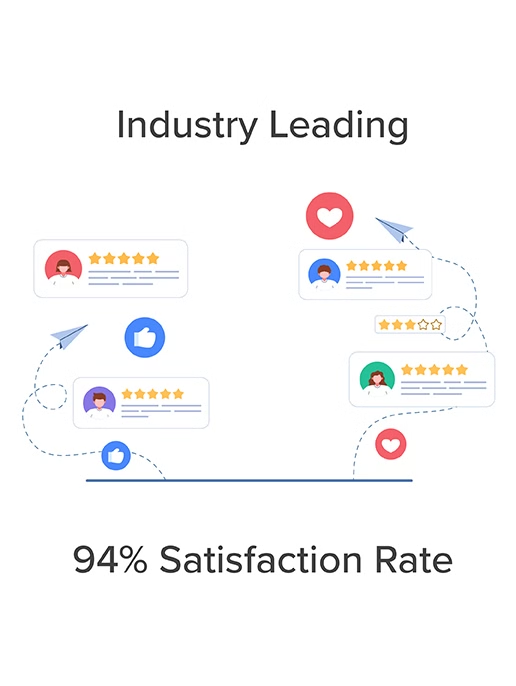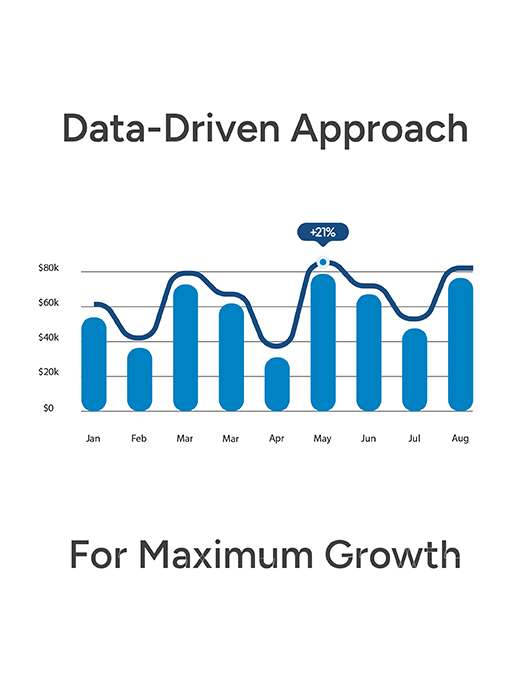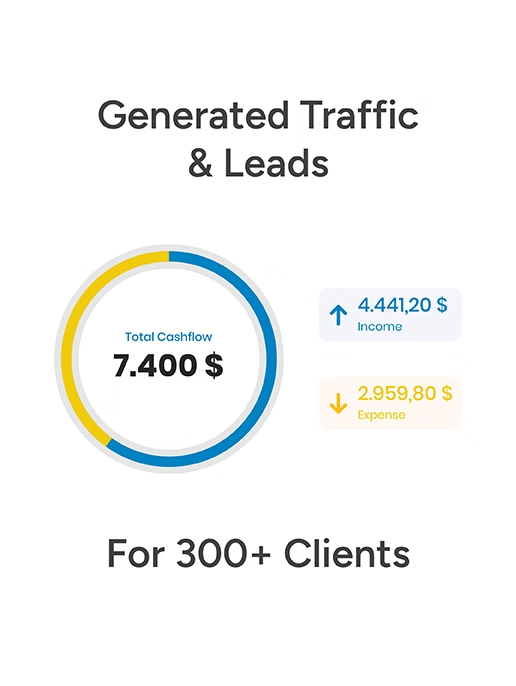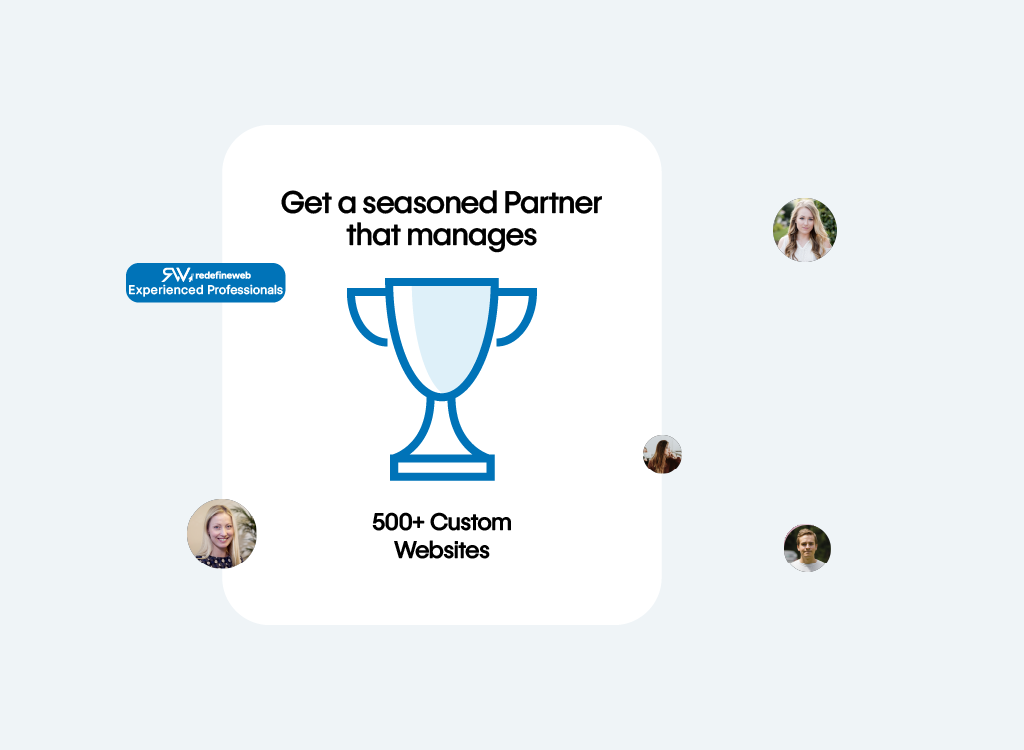


A professional web development agency can charge anywhere from $4,000 to $10,000 to create a website for your psychology practice. For many psychologists, that’s a significant cost that can limit marketing efforts and reduce your online visibility.
Instead, choose one of our dedicated psychologist website packages and get started with a free starter website. We’ve carefully designed these plans to address common challenges psychologists face online—such as building trust, attracting the right clients, ensuring privacy compliance, and optimizing your site for search.
With our comprehensive website packages, we handle all the technical details, so you can focus on what you do best—helping your clients improve their well-being.

A professional and trusted online presence is essential for any psychologist or mental health professional. However, even the most user-friendly website builder can take hours to set up and customize to reflect your unique practice.
At Redefine Web, we provide all-inclusive website solutions designed specifically for psychologists. From design and development to SEO and marketing, we handle every aspect of your online presence.
We work closely with you to understand your practice, your clients, and your professional goals. Our comprehensive approach helps you establish credibility, attract new clients, and make it easier for people to access the care they need.
Psychologists often feel frustrated when looking for an affordable, professional website that truly represents their practice. Many website options come with hidden fees or rising costs after the initial term—leaving practitioners feeling uncertain about where to turn.
Instead of spending hours sorting through complicated choices, work with our team of experienced psychology website designers to create a professional online presence that showcases your expertise and connects with the clients who need your services most.
Most importantly, we build every site with your professional growth in mind. Whether you want to add online booking, client resources, or telehealth integrations in the future, we make it easy—just reach out, and we’ll help you implement it seamlessly.

| Feature | Essential | Growth | Business | Custom |
|---|---|---|---|---|
| Design/Retainer Hours | 5 Hours (One-time) | |||
| Security Patches | ✓ | ✓ | ✓ | ✓ |
| Full-site backup | Monthly | Weekly | Weekly | ✓ |
| Security Scan | Monthly | Weekly | Weekly | ✓ |
| Server Migration | ✓ | ✓ | ✓ | ✓ |
| Copywriting | ✓ | ✓ | ✓ | ✓ |
| Keyword Research | ✓ | ✓ | ✓ | ✓ |
| Blog Posts | ✓ | 1 | 1 | 1 |
| Text Updates | ✓ | ✓ | ✓ | ✓ |
| On-page SEO | ✓ | ✓ | ✓ | ✓ |
| Photos Update | ✓ | ✓ | ✓ | ✓ |
| Off-page SEO |
| Feature | Essential | Growth | Business | Custom |
|---|---|---|---|---|
| Server Side Caching | ✓ | ✓ | ✓ | ✓ |
| HTTP Protocol | ✓ | ✓ | ✓ | ✓ |
| OpCache | ✓ | ✓ | ✓ | ✓ |
| Mod_Expires | ✓ | ✓ | ✓ | ✓ |
| Browser Cache | ✓ | ✓ | ✓ | ✓ |
| Brotli Compression | ✓ | ✓ | ✓ | ✓ |
| CDN | 82 POPs | 82 POPs | 82 POPs | 82 POPs |
| Feature | Essential | Growth | Business | Custom |
| Email Forwarders | ✓ | ✓ | ✓ | ✓ |
| Catch-all Emails | ✓ | ✓ | ✓ | ✓ |
| Email Aliases | ✓ | ✓ | ✓ | ✓ |
| IMAP/POP3/SMTP | ✓ | ✓ | ✓ | ✓ |
| Autoresponders | ✓ | ✓ | ✓ | ✓ |
| Filters | ✓ | ✓ | ✓ | ✓ |
| MX/SPF/DKIM Records | ✓ | ✓ | ✓ | ✓ |
| Email Virus Scanner | ✓ | ✓ | ✓ | ✓ |
| Feature | Essential | Growth | Business | Custom |
|---|---|---|---|---|
| Design/Retainer Hours | 5 Hours (One-time) | |||
| Security Patches | ✓ | ✓ | ✓ | ✓ |
| Full-site backup | Monthly | Weekly | Weekly | ✓ |
| Security Scan | Monthly | Weekly | Weekly | ✓ |
| Server Migration | ✓ | ✓ | ✓ | ✓ |
| Copywriting | ✓ | ✓ | ✓ | ✓ |
| Keyword Research | ✓ | ✓ | ✓ | ✓ |
| Blog Posts | ✓ | 1 | 1 | 1 |
| Text Updates | ✓ | ✓ | ✓ | ✓ |
| On-page SEO | ✓ | ✓ | ✓ | ✓ |
| Photos Update | ✓ | ✓ | ✓ | ✓ |
| Off-page SEO |
We often send out our newsletter with news and great offers. We will never disclose your data to third parties and you can unsubscribe from the newsletter at any time.
Unfortunately, we’re unable to offer free samples. As a retailer, we buy all magazines from their publishers at the regular trade price. However, you could contact the magazine’s publisher directly to ask if they can send you a free copy.
You can create a new account at the end of the order process or on the following page. You can view all of your orders and subscriptions in your customer account. You can also change your addresses and your password.
No, you don’t have to create an account. But there are a few advantages if you create an account.
You never have to enter your billing and shipping address again
Find all of your orders, subscriptions and addresses in your account
Download invoices of your orders
No, we don’t have a physical store location at the moment. We accept only orders through our online shop and we’re shipping all orders with the Swiss Post Service. Please visit our shipping section for more details.
From time to time you will find us at design fairs and popup markets in Switzerland. Subscribe to our newsletter and you’ll receive the latest news.
To maintain fast, reliable performance for every client, we set a soft traffic limit that easily supports the typical psychology practice. If your site begins attracting more visitors — a clear sign your marketing is paying off — we’ll help you move to a plan with greater capacity, faster speeds, and advanced marketing tools so your growth never slows down.
Each paid plan includes professional, domain-based email addresses (e.g., hello@yourpractice.com, billing@yourpractice.com). Dedicated inboxes for inquiries, appointment coordination, and billing help your team stay organized while reinforcing a trustworthy, polished image for your practice.
Your plan includes dedicated design hours for tailoring your psychology website to your brand. During these hours, our design team adjusts colors, layout, and visuals to align with your practice’s message and client experience. Need more personalization—like service pages for specialties, therapy approaches, or intake forms? Extra design hours can be easily added.
Our designers use this time to ensure your website looks inviting, consistent with your brand, and reassuring to potential clients. We’ll personalize the layout, imagery, and overall structure to create a calm, professional experience that encourages visitors to reach out. These hours set a strong foundation, with options to expand as your practice grows.
Yes. If you’d like full ownership of your psychology website and prefer managing hosting yourself, our buyout option gives you complete control. We’ll deliver all design files, content, and step-by-step transition guidance—so your practice can continue to thrive independently.
Most psychology websites are completed within 30 days, depending on how quickly we receive your content and materials. More advanced packages—those that include integrations, client intake forms, or marketing campaigns—may take longer. You’ll always have a clear delivery timeline before we begin.
Yes, you can provide your own copy, photos, and team bios. However, if you'd rather not, our content writers can create engaging, SEO-optimized messaging that reflects your expertise, compassion, and the services you offer—helping attract more clients searching for support in your area.
Absolutely. Every psychology practice has unique goals. Choose from powerful add-ons like Local SEO, Google Ads management, or custom-written service pages for specializations such as anxiety, trauma, or couples therapy. You can scale your site anytime to fit your practice’s evolving needs.
We guarantee 99.9% uptime with all hosting packages, ensuring your website is always available when potential clients are searching for you. Each plan includes SSL encryption, malware protection, and around-the-clock monitoring for secure, uninterrupted performance—at no extra cost.
Heat mapping tracks how visitors interact with your site—where they click, scroll, and spend time. For psychologists, this insight reveals what content resonates most (such as service pages, contact forms, or blog posts), allowing us to fine-tune your site to increase inquiries and client conversions.
UX (User Experience) analysis reveals how easily clients navigate your website. We examine structure, navigation, and flow to ensure visitors can quickly find details about your services, fees, or appointment options. A smooth user experience leads to more inquiries, stronger retention, and improved search visibility.
Our performance optimization keeps your site quick and stable. Fast load times improve the user experience, reduce drop-offs, and strengthen SEO. We continuously test and refine your website’s performance so it runs smoothly across all devices, helping potential clients stay engaged.
Our complimentary Google Ads audit for psychologists evaluates how effectively your current campaigns are performing. Once we have read-only access, we will:
Our free Google Ads audit for dentists analyzes the performance of your current ads, ensuring you get the most out of your marketing spend.
After you grant us read-only access, our experts will:
We’ll then deliver a detailed report with actionable recommendations to help your practice attract more patients and get better returns on advertising.
WordPress optimization focuses on improving your psychology website’s performance and speed — like cleaning up code, compressing images, and enabling caching for quicker load times. This results in a smoother, more engaging experience for potential clients browsing your site.
Maintenance, on the other hand, focuses on ongoing protection and reliability. It includes plugin and theme updates, security enhancements, and technical fixes to keep your website secure and consistent. In short, optimization enhances the user experience; maintenance keeps your site dependable and worry-free.
Our maintenance plans ensure your psychology website always runs fast, securely, and without interruption. We fine-tune code, optimize images and contact forms, and keep your site responsive across all devices. That means potential clients can quickly explore your services, read about your approach, and book appointments seamlessly. We also handle all updates and proactively monitor technical performance—so you can focus on your clients while your site handles the rest.
Core Web Vitals measure how quickly your site loads, how responsive it feels, and how stable it stays during loading—all factors Google uses to rank websites. A strong score helps your psychology practice appear higher in search results, keeps visitors engaged longer, and increases inquiries by creating a smooth, trustworthy browsing experience.
Clear communication ensures your psychology website reflects your vision and client experience. You’ll have access to our project management system for real-time updates and a dedicated project manager (depending on your plan) to answer questions and share progress reports. After launch, you can use your client dashboard for ongoing support. If you’ve added PPC management, your account manager will meet with you regularly to review performance and optimize campaigns for consistent client growth.
Your website’s security is always a top priority. Every plan includes advanced protection powered by CloudLinux and Imunify360 to protect against malware, hacking, and unauthorized access. We run regular vulnerability scans, secure your contact forms, and protect data using QUIC.Cloud’s CDN with Layer-7 DDoS protection. Our infrastructure keeps your website safe, stable, and fully compliant—protecting your clients’ privacy and your professional reputation.
Yes. If you already have a website for your psychology practice, we’ll handle the entire migration for you. Our team transfers your content, images, and data to our optimized platform with minimal downtime—so your practice’s online presence stays intact, becomes faster, and gains the security it deserves.
Absolutely. Every psychology website plan includes automated, off-site backups stored in secure data centers. In the rare event of an issue, we can restore your site quickly—ensuring that your online presence, client inquiries, and appointment requests continue running smoothly without disruption.
All updates and patches go through a careful testing process. We first apply changes in a secure staging environment to ensure everything—especially contact forms and data protection—works perfectly. Once verified, updates are rolled out to your live site with zero interruption. Even on our entry-level plan, your psychology website benefits from continuous monitoring and proactive maintenance.
No. Backup restoration is always included in your psychology website package. If an update or technical issue ever occurs, we can restore your site at no extra cost—so your website stays functional, secure, and ready to generate client leads.
Your psychology website is safeguarded with advanced, multi-layered security. Our servers use firewalls, malware scanners, and intrusion detection to stop threats before they ever reach your site. We also utilize QUIC.Cloud’s CDN with enterprise-grade DDoS protection and apply all security patches immediately upon release. The result is a secure, privacy-focused website that stays online 24/7, ensuring peace of mind for both you and your clients.
Yes — our SEO and PPC management services are designed to help your psychology practice attract more local clients and appear at the top of search results when people look for mental health support in your area. A great website is just the beginning; visibility is what drives growth.
Our SEO strategy targets high-value keywords like “psychologist near me” or “anxiety therapist in [your city].” We handle everything from keyword research and on-page optimization to link building. Because SEO builds momentum over time, we often pair it with PPC campaigns that immediately place your practice at the top of Google search results. Together, these strategies bring you steady, qualified client inquiries and help fill your schedule.
We start by learning about your practice—your specialties, goals, and ideal client profiles. Using professional tools like SEMrush and Google Keyword Planner, we find the most effective keywords such as “couples therapy in [city]” or “child psychologist near me.” Our content team then creates optimized, compassionate copy that connects with readers while improving your search rankings. The result? Higher visibility, more traffic, and more appointment requests.
We refine every part of your psychology website to boost visibility and create a better user experience. From optimizing titles, meta descriptions, and headings to improving internal linking and image tags, we make every detail matter. We also ensure your website loads quickly, looks great on mobile, and is easy to navigate—helping potential clients find the support they need and inspiring confidence in your practice.
Our content team writes engaging, professional copy that builds trust and highlights your expertise. We learn about your services, audience, and local market to create clear, empathetic pages for topics like trauma therapy, anxiety treatment, and relationship counseling. Every piece follows SEO best practices to help your website rank well, attract qualified traffic, and convert visitors into new clients.
Yes. Local SEO is essential for psychotherapists, counselors, and psychologists who serve nearby clients. We optimize your Google Business Profile, manage your directory listings, and encourage authentic reviews to boost visibility in “psychologist near me” searches. Our goal is to help your practice become the top choice for those seeking mental health support in your community.
We provide easy-to-understand reports that show keyword rankings, website traffic, form submissions, and appointment requests. For PPC campaigns, you’ll receive clear metrics on cost per lead, conversion rates, and ROI. Your account manager will review the results with you regularly, explain next steps, and make data-driven adjustments to improve performance continuously.
We offer flexible pricing plans based on your goals and budget. SEO packages can include keyword optimization, local profiles, content creation, and technical audits. PPC costs depend on ad spend and campaign complexity, with full transparency at every step. You’ll always know exactly how your investment is driving new, qualified client bookings.
Most practices start seeing measurable improvements within 3–6 months, depending on competition, location, and your site’s current performance. SEO is a long-term strategy, but as content and site authority grow, you’ll notice more inquiries and steady increases in traffic from people actively seeking psychological support.
We build your campaigns around the services you want to promote most — targeting search terms such as “EMDR therapy in [city],” “depression counseling near me,” or “child psychologist [city].” We write ad copy that reassures and engages potential clients while emphasizing your unique approach. Our continuous monitoring and optimization process ensures your ads deliver exceptional ROI and drive meaningful results.
We identify your ideal client demographics—location, age group, and therapy needs—to target those most likely to connect with your services. We also run remarketing ads that remind previous visitors about your practice, encouraging them to book when they’re ready. Each campaign is closely tracked and fine-tuned to lower acquisition costs while increasing the number of quality client leads.
Starting is easy. Choose one of our psychology website plans and share a few details about your practice — your logo, services, location, and any preferences. From there, our team takes care of everything from setup to launch, creating a professional site that helps potential clients discover, trust, and reach out to your practice online. (If you’d like help with content creation, our SEO copywriting add-on can handle that for you too.)
Yes! Every psychologist website we build includes a simple, user-friendly content management system. You or your staff can easily update service pages, post blogs, add new images, or adjust text anytime—no tech skills needed.
All our packages include secure, high-speed hosting optimized for psychology practices. You can transfer your site anytime after a one-time buyout if you prefer another host. However, we recommend staying on our servers for top performance, enhanced security, and full technical support.
Absolutely. Your team can log in anytime to add bios, publish helpful articles, or update resources for clients. It’s quick, intuitive, and requires no coding experience. Prefer to let a professional handle updates? Our content creation add-on provides ongoing, SEO-friendly updates for you.
Our hosting is built to scale with your practice. The base plan supports up to 10,000 visits per month—plenty for most individual psychologists or small clinics. As your website traffic grows, we’ll guide you through a seamless upgrade to support more visitors while keeping your site fast and reliable.
Yes. Every psychology website we create is optimized for search visibility from the start. We focus on site speed, mobile responsiveness, and proper page structure so your practice ranks higher in local search results. Want to attract more clients faster? Our SEO add-on optimizes your content around your most valuable therapy services and keywords.
A design hour is dedicated time our design team spends customizing your psychology website. During these hours, we adjust the layout, colors, and imagery to suit your brand and the calming, professional tone you want to convey. Our standard package includes four design hours—enough to create a clean, polished look. Need more customization? Additional hours can easily be added.
Yes, you’re welcome to provide your own text and images if you’d like. But if you prefer a hands-off experience, our copywriting team can create SEO-friendly, client-focused content for your pages. The Copywriting add-on ensures your site’s messaging feels authentic while also attracting local clients searching for psychological services online.
Definitely. Every psychology practice has unique goals and requirements. Whether you’d like more pages, online intake forms, or a custom design, we’ll prepare a quote that fits your vision, timeline, and budget—so your website reflects your professional identity from day one.
Our managed hosting takes the technical stress out of running your psychology website—so you can stay focused on supporting your clients. You’ll get access to 500+ ready-to-build templates, including layouts thoughtfully designed for mental health professionals.
Each plan includes four hours of customization to match your logo, colors, and branding, plus five professional email accounts, daily off-site backups, and 24/7 monitoring. We handle performance tuning, updates, and security, ensuring your practice has a stable, worry-free online presence from day one.
As your client base expands and web traffic increases, our hosting scales effortlessly with you. If your site exceeds 10,000 monthly visits, we’ll upgrade your plan seamlessly—no downtime, no disruption. You can also add services like professional copywriting, psychology-specific SEO, or blog content to keep your growth consistent and sustainable. Whether you’re building a solo practice or managing multiple clinics, your website will always run smoothly and securely.
We take security seriously. Our hosting is protected with multiple layers of defense, including advanced firewalls, intrusion detection, and routine updates—all designed to support healthcare-level data protection standards. With continuous monitoring and daily backups, your website remains safe, compliant, and fully recoverable, protecting both your practice and your clients’ confidentiality.
Yes. We’ll migrate your existing website with zero data loss and minimal downtime. Our team will transfer all pages, content, and settings smoothly while maintaining your current SEO rankings and structure. Once the migration is complete, your site will load faster, perform better, and enjoy stronger protection on our platform.
If you surpass 10,000 monthly visits, we’ll reach out to recommend an upgrade that’s right for your traffic levels. Occasional spikes won’t trigger immediate fees—our flexible hosting grows with your success, keeping your site reliable and fast as your visibility increases.
Our servers are located across North America and Europe. We’ll host your psychology website on the closest network to your location for the fastest loading times and smooth browsing experiences for your clients.
Absolutely. We’ll tailor your plan to fit your practice’s exact needs, whether that means extra storage, faster load speeds, or added security layers. As your practice evolves, we can adjust your hosting features to ensure your online presence remains strong, professional, and secure.
Yes. If you already have a fully designed site, we can host it for you. You’ll benefit from top-tier performance, daily backups, proactive monitoring, and responsive technical support—all without the need for additional design services. It’s perfect for psychologists who simply want reliable, managed hosting.
Monthly subscribers can export content after one year, while annual plan holders can export anytime. If you ever decide to switch hosting providers, we’ll coordinate the handoff carefully to avoid downtime and keep your site fully accessible during the transition.
Buyout fees vary based on the level of customization and development completed for your site. We always provide a clear, transparent quote so you can make an informed decision. Our goal is to give your practice complete ownership and flexibility—on your own terms.
